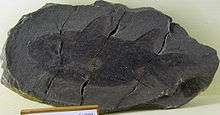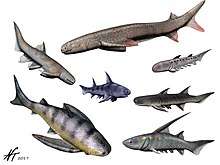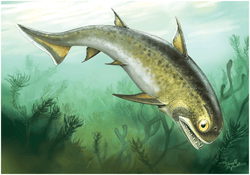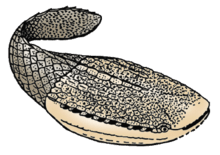Acanthodii
Acanthodii or acanthodians (sometimes called spiny sharks) is an extinct paraphyletic class of teleostome fish, sharing features with both bony fish and cartilaginous fish. In form they resembled sharks, but their epidermis was covered with tiny rhomboid platelets like the scales of holosteans (gars, bowfins). They represent several independent phylogenetic branches of fishes leading to the still extant Chondrichthyes.[1]
| Acanthodii | |
|---|---|
 | |
| Acanthodes sp. | |
| Scientific classification | |
| Kingdom: | Animalia |
| Phylum: | Chordata |
| Clade: | Eugnathostomata |
| Class: | †Acanthodii Owen, 1846 |
| Orders | |
| |
The popular name "spiny sharks" is a partial misnomer for these early jawed fishes. The name was coined because they were superficially shark-shaped, with a streamlined body, paired fins, and a strongly upturned tail; stout, largely immovable bony spines supporting all the fins except the tail - hence, "spiny sharks"; in retrospect, however, their close relation to modern cartilaginous fish can lead them to be considered "stem-sharks". Fossilized spines and scales are often all that remains of these fishes in ancient sedimentary rocks. Although not sharks or cartilaginous fish, acanthodians did, in fact, have a cartilaginous skeleton, but their fins had a wide, bony base and were reinforced on their anterior margin with a dentine spine. The earliest acanthodians were marine, but during the Devonian, freshwater species became predominant.
There are four orders recognized: Climatiiformes, Ischnacanthiformes, Acanthodiformes and Diplacanthiformes[2]. Climatiiforma had shoulder armor and many small sharp spines, Ischnacanthiforma with teeth fused to the jaw, and the Acanthodiforma were filter feeders, with no teeth in the jaw, but long gill rakers. Overall, the acanthodians' jaws are presumed to have evolved from the first gill arch of some ancestral jawless fishes that had a gill skeleton made of pieces of jointed cartilage.
Paraphyletic groupings are problematic, as one can not talk precisely about their phylogenic relationships, their characteristic traits and literal extinction.[3][4]
Characteristics


The scales of Acanthodii have distinctive ornamentation peculiar to each order. Because of this, the scales are often used in determining relative age of sedimentary rock. The scales are tiny, with a bulbous base, a neck, and a flat or slightly curved diamond-shaped crown.
Despite being called "spiny sharks," acanthodians predate sharks. Scales that have been tentatively identified as belonging to acanthodians, or "shark-like fishes" have been found in various Ordovician strata, though, they are ambiguous, and may actually belong to jawless fishes such as thelodonts. The earliest unequivocal acanthodian fossils date from the beginning of the Silurian Period, some 50 million years before the first sharks appeared. Later, the acanthodians colonized fresh waters, and throve in the rivers and lakes during the Devonian and in the coal swamps of Carboniferous. By this time bony fishes were already showing their potential to dominate the waters of the world, and their competition proved too much for the spiny sharks, which died out in Permian times (approximately 250 Million years ago).
Many palaeontologists originally considered the acanthodians close to the ancestors of the bony fishes. Although their interior skeletons were made of cartilage, a bonelike material had developed in the skins of these fishes, in the form of closely fitting scales (see above). Some scales were greatly enlarged and formed a bony covering on top of the head and over the lower shoulder girdle. Others developed a bony flap over the gill openings analogous to the operculum in later bony fishes. However, most of these characteristics are considered homologous characteristics derived from common placoderm ancestors, and present also in basal cartilaginous fish.
Taxonomy and phylogeny
In a study of early jawed vertebrate relationships, Davis et al. (2012) found acanthodians to be split among the two major clades Osteichthyes (bony fish) and Chondrichthyes (cartilaginous fish). The well-known acanthodian Acanthodes was placed within Osteichthyes, despite the presence of many chondrichthyan characteristics in its braincase.[5] However, a newly described Silurian placoderm, Entelognathus, which has jaw anatomy shared with bony fish and tetrapods, has led to revisions of this phylogeny: acanthodians were then considered to be a paraphyletic assemblage leading to cartilaginous fish, while bony fish evolved from placoderm ancestors.[6]
Burrow et al. 2016 provides vindication by finding chondrichthyans to be nested among Acanthodii, most closely related to Doliodus and Tamiobatis.[7] A 2017 study of Doliodus morphology points out that it appears to display a mosaic of shark and acanthodian features, making it a transitional fossil and further reinforcing this idea.[8]
References
- Zhu, Min; Yu, Xiaobo; Ahlberg, Per Erik; Choo, Brian; Lu, Jing; Qiao, Tuo; Qu, Qingming; Zhao, Wenjin; Jia, Liantao; Blom, Henning; Zhu, You'an (2013). "A Silurian placoderm with osteichthyan-like marginal jaw bones". Nature. 502 (7470): 188–193. Bibcode:2013Natur.502..188Z. doi:10.1038/nature12617. PMID 24067611.
- Burrow, C. Blaauwen, J D. Newman, M. and Davidson, R. (2016). The diplacanthid fishes (Acanthodii, Diplacanthiformes, Diplacanthidae) from the Middle Devonian of Scotland. Society for Vertebrate Paleontology,19.1.10A https://doi.org/10.26879/601
- Schilhab, Theresa; Stjernfelt, Frederik; Deacon, Terrence (2012-03-26). The Symbolic Species Evolved. Springer Science & Business Media. ISBN 9789400723351.
- Villmoare, Brian (2018-01-30). "Early Homo and the role of the genus in paleoanthropology". American Journal of Physical Anthropology. 165: 72–89. doi:10.1002/ajpa.23387. ISSN 0002-9483. PMID 29380889.
- Davis, S. P.; Finarelli, J. A.; Coates, M. I. (2012). "Acanthodes and shark-like conditions in the last common ancestor of modern gnathostomes". Nature. 486 (7402): 247–50. Bibcode:2012Natur.486..247D. doi:10.1038/nature11080. PMID 22699617.
- Barford, Eliot (September 25, 2013). "Ancient fish face shows roots of modern jaw". Nature. doi:10.1038/nature.2013.13823. Archived from the original on 2013-10-31. Retrieved September 26, 2013.
- Carole Burrow; Jan den Blaauwen; Michael Newman; Robert Davidson (2016). "The diplacanthid fishes (Acanthodii, Diplacanthiformes, Diplacanthidae) from the Middle Devonian of Scotland". Palaeontologia Electronica 19 (1): Article number 19.1.10A.
- G., Maisey, John; 1956-, Miller, Randall F. (Randall Francis); Alan., Pradel; S., Denton, John S.; Allison., Bronson; Philippe., Janvier (2017-03-10). "Pectoral morphology in Doliodus : bridging the 'acanthodian'-chondrichthyan divide. (American Museum Novitates, no. 3875)". hdl:2246/6701. Cite journal requires
|journal=(help)CS1 maint: numeric names: authors list (link)
Further reading
- Beneš, Josef (1979), Prehistoric Animals and Plants, New York: Hamlyn, ISBN 978-0-600-30341-1
- Janvier, Phillipe (1996), Early vertebrates, Oxford: Clarendon Press, ISBN 978-0-19-854047-2
- Long, John A. (1995), The Rise of Fishes: 500 Million Years of Evolution, Baltimore: Johns Hopkins University Press, ISBN 978-0-8018-4992-3
- Palmer, Douglas, ed. (1999), The Simon & Schuster Encyclopedia of Dinosaurs & Prehistoric Creatures. A Visual Who's Who of Prehistoric Life, New York: Simon & Schuster, ISBN 978-0-684-86411-2
External links
- Acanthodii taxonomy
- †Ischnacanthiformes taxonomy
- †Climatiiformes taxonomy
- †Acanthodiformes taxonomy
- "PALAEOZOIC FISH UK". Archived from the original on 2012-10-11.
- Acanthodopsis wardi

